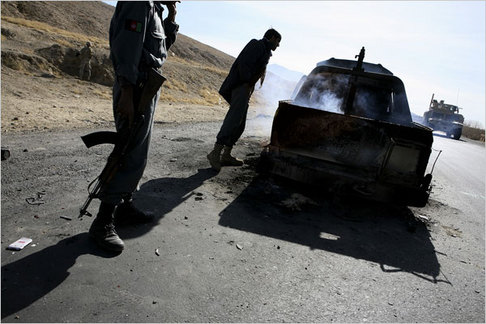[Part one of a two-part series on the conflict in western Afghanistan.]
The desolate, hardscrabble desert provinces of southwestern Afghanistan have increasingly been targeted by Taliban insurgents and criminal elements. The ferocity of the attacks, and their frequency threaten to derail the feeble grip the central government struggles to maintain over this vulnerable area. Farah and Nimroz provinces have both suffered a surge in suicide attacks and deadly clashes at police checkpoints and government centers.
On April 17, a Taliban suicide bomber detonated himself at a crowded marketplace in Zaranj, the provincial capital of Nimroz, killing 27 people and wounding more than 40 others. That same week, another Taliban suicide bomber detonated in a crowd of international road workers employed by the Indian Army’s Border Reconstruction Organization (BRO), killing two highly regarded Indian engineers and an Afghan civilian. Five other BRO employees were seriously wounded in the attack.
Once extremely rare in this region of Afghanistan, suicide bombings have struck Nimroz at least six times since November. The first suicide bombing of this cycle occurred on Nov. 17 and nearly killed the provincial governor as he and his entourage attempted to leave the governor’s compound. The governor’s son and six bodyguards were killed in the blast, and several civilians were injured. The other suicide attacks targeted BRO workers in January along with police units and their commanders.
April’s deadly suicide attacks highlight the Taliban’s decision to repeat last year’s spring offensive strategy, which includes disruptive attacks against non-military targets, infrastructure and those working to rebuild it. Last year’s Taliban campaign, Operation Kamin (Ambush), resulted in the deaths of more than 900 Afghan security personnel and incorporated the intensified use of suicide bombers and improvised-explosive devices. The number of lethal attacks against non-military targets, infrastructure and those working to rebuild it has increased since Mullah Berader, the self-described Deputy Emir of the Taliban, announced the start of the Taliban’s spring offensive in mid-March. Dubbed Operation Ebrat (Lesson), the Taliban’s 2008 offensive aims to spread the conflict countrywide, a trend progressively more evident in the troubled southwest.
Blood on the Asphalt
Recent suicide attacks, ambushes and roadside bombs have killed dozens of security officers, policemen, and foreign workers in southwestern Afghanistan. Most of these attacks took place on or near Nimroz’s most crucial construction project, the 218-kilometer Zaranj-Delaram highway. The $80 million road project will eventually link Zaranj, which is on the Afghan-Iran border, with the city of Delaram in neighboring Farah province. Delaram sits along the refurbished Herat-Kandahar highway, also known as Highway 1, which connects the western city of Herat to Kandahar and Kabul.
The Zaranj-Delaram highway is funded by the Indian government and is being paved by the Indian Army’s Border Reconstruction Organization (BRO), the ad hoc Provincial Reconstruction Team for Nimroz province. The deteriorating security situation has delayed the road project by nearly a year and has doubled the overall cost to $180 million. The Taliban have demanded the withdrawal of all Indian nationals working in Afghanistan since reconstruction efforts began in 2002 and have repeatedly attacked them since. Indian engineers have worked in Nimroz since 2004 and lost their first employee to Taliban savagery in 2005.
“It has been a challenging project,” Sandeep Kumar, the deputy chief for Indian’s embassy in Kabul, told the Long War Journal in a recent communiqu









6 Comments
Syed Saleem Shahzad (in part 2 of a series of 3 articles) has an interview with Qari Ziaur Rahman who is ostensibly the commander of the Taliban in Nooristan and Kunar provinces. In the interview Rahman talks bravely of the Taliban’s successes in Kunar province.
Asia Times: A fighter and a financier
Dr. David Kilcullen, a one-time adviser for General Petraeus in Iraq, has a different view of what’s going on in Kunar province.
Small Wars Journal: Road-Building in Afghanistan
I find Dr. Kilcullen’s version of events much more believable.
Good stuff Matt thx. Marlin thanks for the additional links and info.
Forgive me, but what do Mimroz and Kunar have to do with one another? They are opposite sides of the country with different enemies (a majority of those fighting ISAF in Kunar are NOT Taleb).
David –
Thanks for your note. And also thanks for your posts at The Long War Journal in the recent past as well. I enjoyed them a great deal.
I agree that Nimruz and Kunar are on opposite sides of the country. In that sense my comment was off-topic.
Syed Saleem Shahzad can be a bit hyperbolic, I agree. However, there is usually a truthful streak running through his articles. When he says he’s talking to a Taliban commander, from years of reading him, I take him at his word on that.
Again, many thanks for going to Iraq and Afghanistan and reporting back to the rest of us in the forum of pictures.
I’m a little confused about the “part 2” note at the end of this article. When was part 1 published?
Also, is there any evidence of collusion between the Taliban and Baloch insurgents in Iran or Pakistan?
Part 1 was published on May 22.
Asia Times: Ducking and diving under B-52s